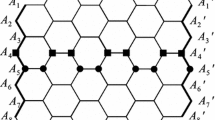Abstract
The electronic structure and dielectric screening of finite-length armchair carbon nanotubes are studied with both tight-binding and ab initio methods. Good agreement is found in the band gap oscillation patterns and dielectric constants, which validates the tight-binding method as a reliable and fast approach to describe the screening effect of carbon nanotubes. For an illustration, our method is applied to a system consisting of a short (6,6) nanotube filled with six water molecules. Substantial screening of the water dipoles through the nanotube is observed. This polarization effect should have an important influence on the permeation of water and other biomolecules inside carbon nanotubes.
Similar content being viewed by others
References
G. Hummer, J.C. Rasaiah, and J.P. Noworyta, Nature, 414, 188 (2001).
A.I. Kolesnikov, J.-M. Zanotti, C.-K. Loong, P. Thiyagarajan, A.P. Moravsky, R.O. Loutfy, and C.J. Burnham, Phys. Rev. Lett., 93, 035503 (2004).
D. Lu, Y. Li, S.V. Rotkin, U. Ravaioli, and K. Schulten, Nano Lett., 4, 2383 (2004).
D.J. Mann and M.D. Halls, Phys. Rev. Lett., 90, 195503 (2003).
A.D. Becke, J. Chem. Phys., 98, 5648 (1993).
M.J. Frisch et al., Gaussian 03, Revision C.01, (Gaussian Inc., Wallingford, CT 2004).
S. Reich, J. Maultzsch, C. Thomsen, and P. Ordejón, Phys. Rev. B, 66, 035412 (2002).
Although Mulliken charges are not fit to and in many circumstances do not match the electrostatic potential, we find in our case the change in Mulliken charges to reproduce the in electrostatic potential fairly well.
D. Lu, Y. Li, U. Ravaioli, and K. Schulten, J. Phys. Chem B, in press (web released on May 18, 2005).
S. Joseph, R.J. Mashl, E. Jakobsson, and N.R. Aluru, Nano Letters, 3, 1399 (2003).
S. Vaitheeswaran, J.C. Rasaiah, and G. Hummer, J. Chem. Phys., 121, 7955 (2004).
F. Zhu and K. Schulten, Biophys. J., 85, 236 (2003).
Author information
Authors and Affiliations
Corresponding author
Rights and permissions
About this article
Cite this article
Li, Y., Lu, D., Schulten, K. et al. Screening of Water Dipoles Inside Finite-Length Armchair Carbon Nanotubes. J Comput Electron 4, 161–165 (2005). https://doi.org/10.1007/s10825-005-7130-9
Issue Date:
DOI: https://doi.org/10.1007/s10825-005-7130-9




